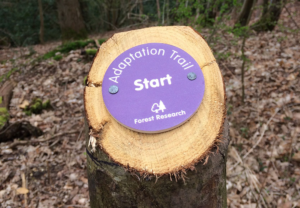
Our climate is changing but what are we doing to understand how we can adjust our woodland management practices to better prepare our woodlands?
Dr Gail Atkinson, Forest Research, discusses a new climate change adaptation trail and demonstration areas located in Alice Holt Forest.
What is being done?
Alice Holt Forest is located on the Surrey/Hampshire border and is within the South Downs National Park. The forest contains a mix of broadleaf tree species and coniferous woodland which provides many important benefits. The future climate for the area is expected to include hotter, drier summers along with more frequent extreme weather events, such as droughts, which could lead to significant reductions in tree growth, biodiversity and ecosystem services such as carbon sequestration.
Three new demonstration areas have been set up by Forest Research and Forestry England to show climate change adaptation measures in a woodland typical of the South East of England. They have been designed to show examples of adaptive management and planning for future conditions which may better prepare our woodlands for change and future challenges.
The planning, operations and implementation of the measures have already provided insights into the practicalities of adapting to future changes. The intention is that as they grow, they will continue to develop our learning about the process and impact of implementing adaptation actions in forestry, and encourage others to think about what measures might work best in their woodlands and share their ideas and experiences.
These demonstration areas have been incorporated into the ‘Alice Holt Climate Change Adaptation Trail’. The trail is designed to show a range of adaptation measures and options. As well as the new demonstration areas it also includes 20th century research trials (some dating back to 1943) and the Alice Holt Arboretum, which are today of fresh interest to those considering how to build resilience in woodlands to environmental change.

What can I see along the trail?
The trail incorporates:
- A demonstration of species diversification to increase resilience, meet restoration objectives and improve drought tolerance;
- Management interventions to explore opportunities to reduce drought stress and the impact of pests and diseases;
- Techniques for woodland creation to support carbon sequestration;
- A direct seeding trial of 10 tree species sown in 2009 to stimulate thinking about whether we can encourage natural selection using direct seeding;
- A trial of Coast redwood (Sequoia sempervirens) which involved testing the growth and survival of plants raised from seed in different regions, to encourage forest managers to consider options to address changing fire risk;
- A clone bank of Leyland cypress to demonstrate what species trials can tell us about future risks;
- A clone bank of Western red cedars (Thuja plicata) to encourage thinking about what alternative species might suit future conditions;
- The Alice Holt Arboretum to illustrate how species diversification and conservation work are important in understanding threats and opportunities from the changing climate.

How can I visit the demonstration areas and the adaptation trail?
The trail starts in Alice Holt Arboretum car park which is located near to Forest Research’s Alice Holt Lodge and two miles from Alice Holt Forest Park. A self-guided trail guide and associated worksheet are available to download from the Forest Research website.
We hope this inspires you to find out more about the demonstration work, to come along to take a look at what is happening and let us know what you think.
Disclaimer: The views and opinions expressed in this article are those of the author and do not necessarily reflect the views of the Institute of Chartered Foresters.






